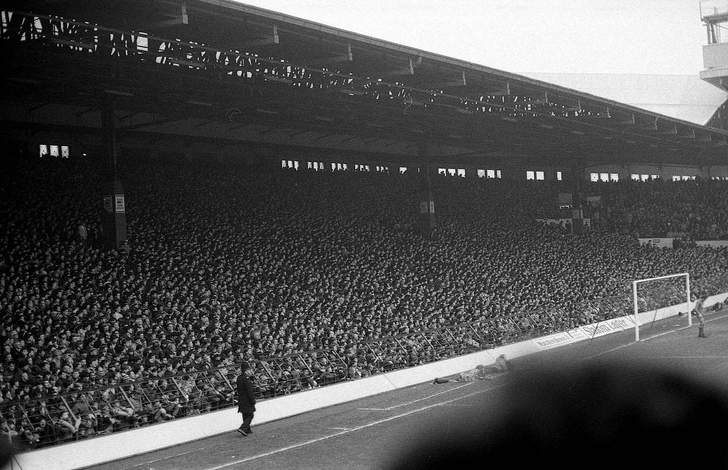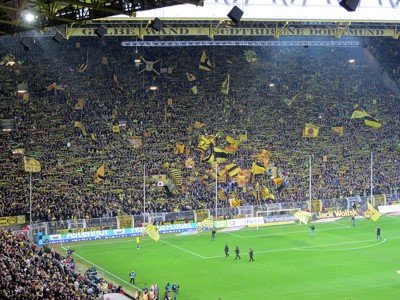Football is more than just a game. It’s the passion and loyalty of the supporters that make it truly special. As fans, we show our support by heading to the stadiums and standing by our teams through thick and thin. And in these stadiums, certain stands have become famous in their own right.
In this article, we’ll explore the top six most famous stands in football and delve into why they hold such significance. From the history to the atmosphere, these stands have captivated the hearts of football fans around the world.
Bạn đang xem: The Most Famous Football Stands
The Kop – Anfield
Steve Daniels / A full Kop End in 1983
Arguably the most renowned stand in world football, the Kop at Anfield is where the passionate Liverpool supporters come together on match days. Its story began in 1906 when a new stand was built behind one of the goals to celebrate the team’s second league championship. The Sports Editor of the Liverpool Echo and the Liverpool Daily Post, Ernest Edwards, named it the Spion Kop after a famous hill in South Africa that held historical significance.
Over the years, the Kop grew in size and became iconic for its ability to create an electric atmosphere. It hosted more than 30,000 standing spectators and became the largest Kop in the country. The Kop’s reputation reached its peak during European nights when it was believed to have the power to “suck the ball into the back of the net.” It also became famous for singing along with the top chart-topping song before kick-off, with “You’ll Never Walk Alone” by Gerry & The Pacemakers becoming the club anthem.
Though the Kop had to be transformed into an all-seater stand after the Hillsborough Disaster, it still remains a symbol of unwavering support for Liverpool. A statue of Bill Shankly stands proudly in front of it, and it continues to provide a stage for epic displays of fan support.
The Yellow Wall – Westfalenstadion
Markus Unger from Vienna, Austria, CC BY 2.0, via Wikimedia Commons
Located at Signal Iduna Park, the Yellow Wall is the beating heart of Borussia Dortmund. The stand derives its name from the club’s yellow home kit and is the largest standing terrace in Europe, accommodating 24,454 fans. Its reputation as a formidable force is well-deserved, as it played a vital role in Dortmund’s unbeaten home record during the 2012-2013 campaign.
The Yellow Wall’s influence on matches is undeniable, even when UEFA rules require supporters to be seated during European matches. Players have spoken about the intimidation they feel when facing Dortmund’s passionate fans, with the stand having earned a reputation as a fearsome force. The unity and unwavering support displayed by fans from all walks of life create an atmosphere that is the heartbeat of Borussia Dortmund.
The Westfalenstadion, home to the Yellow Wall, was initially built for the 1974 FIFA World Cup and has undergone numerous expansions since then. The unique inclined angle of the stand, combined with the sea of yellow and black, contributes to its iconic status and the daunting experience it offers opposition players.
The South Stand – Tottenham Hotspur Stadium
Open since 2019, the South Stand at the Tottenham Hotspur Stadium stands as a testament to modern architectural design. It is the largest single-tier stand in English football, with a seating capacity of 17,500 fans. The stand’s 34-degree angle and proximity to the pitch were carefully considered to create an intense atmosphere.
The Tottenham Hotspur Stadium, a £1 billion masterpiece, was designed like a concert hall, focusing on creating exceptional acoustics to enhance the match day experience. At first glance, the bowl design might not reveal distinct stands, but the South Stand stands out with its unique design inspired by the Yellow Wall. It aims to become the heartbeat of the stadium, generating a wall of sound that reverberates throughout.
While the South Stand’s story is yet to be written in terms of on-field successes, it has already captured the imagination of the most passionate Tottenham fans. Its impressive design and potential for legendary moments make it a standout feature of the stadium.
Gallowgate End – St James’ Park
dom fellowes from UK, CC BY 2.0, via Wikimedia Commons
At St James’ Park, the Gallowgate End stands as a testament to the unwavering loyalty of Newcastle United’s supporters. Despite the club’s limited success in recent years, the vocal nature of the fans ensures the Gallowgate End remains respected in the realm of football.
The Gallowgate End, located at the end where the city’s gallows once stood, has been the centerpiece of St James’ Park since its opening in 1892. It has undergone several redevelopments, with major alterations in 1993 and 2005. The stand’s capacity has increased over the years, and it continues to be the focal point for Newcastle supporters.
In addition to the Gallowgate End, the corner between the Gallowgate End and the East Stand, affectionately known as the “Strawberry Corner,” has become a singing section. Tens of thousands of passionate Geordies cheering on their team have made this section of the stadium known for its incredible atmosphere.
Lisbon Lions Stand – Celtic Park
Celtic fans are renowned for their passion and dedication to their club, and Celtic Park, also known as Parkhead or “Paradise,” resonates with their unwavering support. The stadium, which opened in 1892, has witnessed record attendances and has hosted Scottish international matches.
Xem thêm : Premier League Stadiums & Stats
The Lisbon Lions Stand, named in honor of the team that won the European Cup, holds a special place in the hearts of Celtic supporters. The stand underwent redevelopment in the 1990s and added a safe standing section in 2016. This unique section, with rail seating accommodating 2,600 fans, amplifies the already incredible atmosphere of the Lisbon Lions Stand.
Celtic Park’s rich history and the passionate support of the fans have solidified the Lisbon Lions Stand’s place among football’s most famous stands.
FAQs
-
What is the most famous stand in football?
- The most famous stand in football is the Kop at Anfield, home of Liverpool FC.
-
Which stand is known as the Yellow Wall?
- The Yellow Wall stands at Signal Iduna Park, the home of Borussia Dortmund.
-
What is the largest single-tier stand in English football?
- The South Stand at the Tottenham Hotspur Stadium is the largest single-tier stand in English football.
-
Where is the Gallowgate End located?
- The Gallowgate End is located at St James’ Park, home of Newcastle United.
-
Why is the Lisbon Lions Stand famous?
- The Lisbon Lions Stand at Celtic Park is famous for its passionate Celtic supporters and its unique safe standing section.
Conclusion
Football stands have the power to ignite passion, create an electric atmosphere, and leave an indelible mark on the hearts of supporters. The Kop, the Yellow Wall, the South Stand, the Gallowgate End, and the Lisbon Lions Stand are not just structures in stadiums; they are hallowed grounds that capture the essence of football fandom.
These famous stands symbolize the unwavering loyalty, dedication, and love that fans have for their clubs. They stand as testaments to the power of unity, inspiring players and supporters alike. As we continue to witness the magic of football, these stands will forever hold a special place in the beautiful game. For more football-related news and insights, visit Movin993.
Nguồn: https://movin993.com
Danh mục: Tin tức








